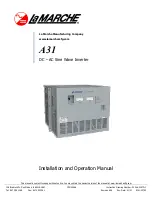
•
X-10 home automation systems
•
Oxygen concentrators and other medical equipment
Most battery chargers can be connected to the AC receptacle. Battery chargers that use separate
transformers or chargers that plug into the AC receptacle to supply a low-voltage DC-to-AC output
should work. However, battery chargers for small nickel-cadmium batteries can be damaged if plugged
into the Inverter.
The following appliances or devices could be damaged if plugged into the Inverter:
• Small battery-operated appliances that can be plugged directly into the AC receptacle such as
flashlights, cordless razors and toothbrushes.
• Certain battery chargers for cordless tool battery packs. These chargers can be identified by a
warning label stating dangerous voltages are present at the battery terminals.
Monitor the temperature of the battery charger for about 10 minutes. If the battery
charger becomes abnormally warm, disconnect it from the Power Inverter immediately.
If you are unsure about powering any appliance or device with the Inverter, contact the manufacturer
or consult the owner’s manual of the device.
Determining Power Consumption (Current Draw of Equipment)
FIRE HAZARD
Do not operate high-wattage appliances or equipment that will produce heat, such as hair
dryers, irons, heaters and toasters, with this Inverter.
Ensure that total power consumption of the device being used is less than the
rating of the Inverter.
The manufacturer provides a label with power consumption information in watts or amps for their
product. If the item’s power consumption is not indicated in watts, but in amps AC, multiply the amp
AC value by 120 (AC volts) to determine the wattage.
When you turn on an appliance or device, it will require twice the rated wattage
of the appliance or device to start. This is known as the “starting load” or “peak load.” To
determine the starting load or peak load, multiply the rated wattage by two. If this exceeds the
peak surge output of the Inverter (2400 watts [0.4 sec]), do not operate the appliance or device
with the Inverter.
The Power Inverter can operate a resistive load device or an inductive load device.
Operating a resistive load device is the easiest for the Inverter. However, the Inverter will not operate
larger resistive load devices such as electric stoves and heaters. Their resistive load requires higher
wattage than the Inverter can produce.
TVs and stereos are inductive load devices (devices with a coil or transformer). They may require
more current to operate than a resistive load device of the same wattage rating.
The following is a list of typical wattages of various appliances (the below wattage ratings are
estimates only):
•
19" color TV
100 watts
•
Power drill
400 watts
•
Computer system
400 watts
•
8-cup coffeemaker
600 watts
•
Microwave oven
900 watts
Power Source
The Power Inverter can be connected to a 12-volt battery, multiple 12-volt batteries connected in
parallel for heavy-duty installations or a regulated 12-volt DC power source. The power source must
provide between 11 and 15 volts DC and must be able to provide sufficient current (in amperes) to
operate multiple devices.
Do not exceed the maximum input voltage of 15 volts DC. The Inverter could be
damaged.
The Power Inverter is for 12-volt battery systems only. A 6-volt battery system will
not provide adequate input voltage and a 24-volt battery system will damage the Inverter.
Determining Battery Capacity and Operating Time
To determine your battery capacity, you will need to know the wattage of each appliance and/or tool
that will be simultaneously powered by the Inverter. Keep in mind to add 15% to the wattage of each
appliance and/or tool due to efficiency loss using the Inverter. Once you have determined the total
wattage, use the following formula to determine the battery capacity in amp-hours and the operating
time between charges. For this example, we will use a 12-volt DC battery rated at 200 amp-hours.































